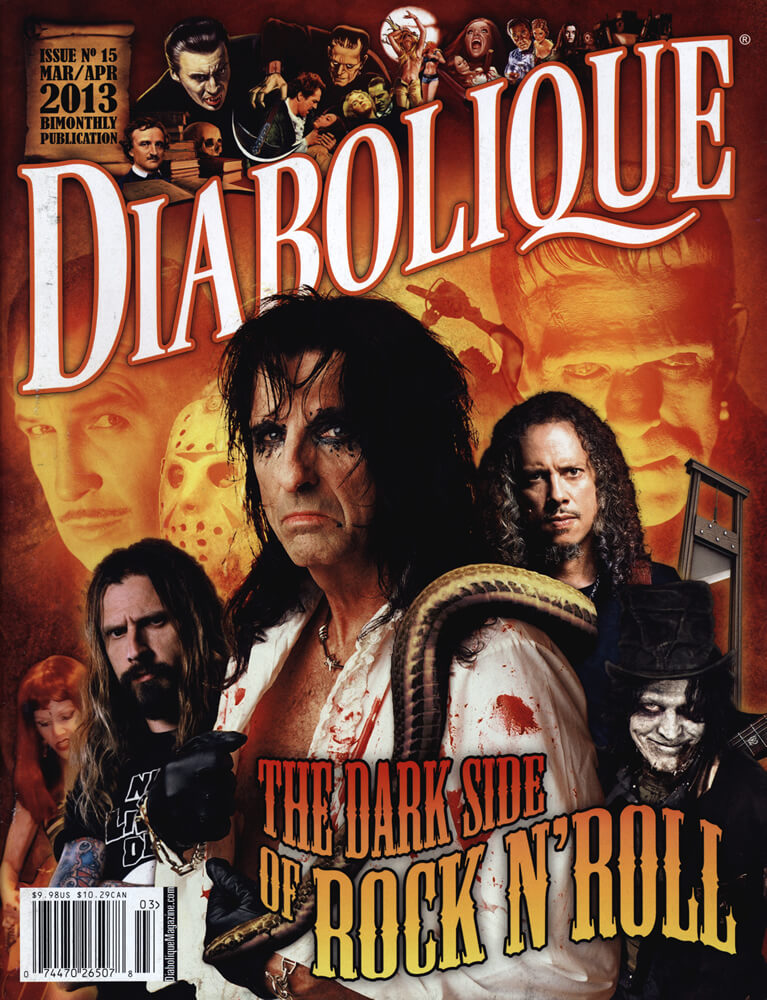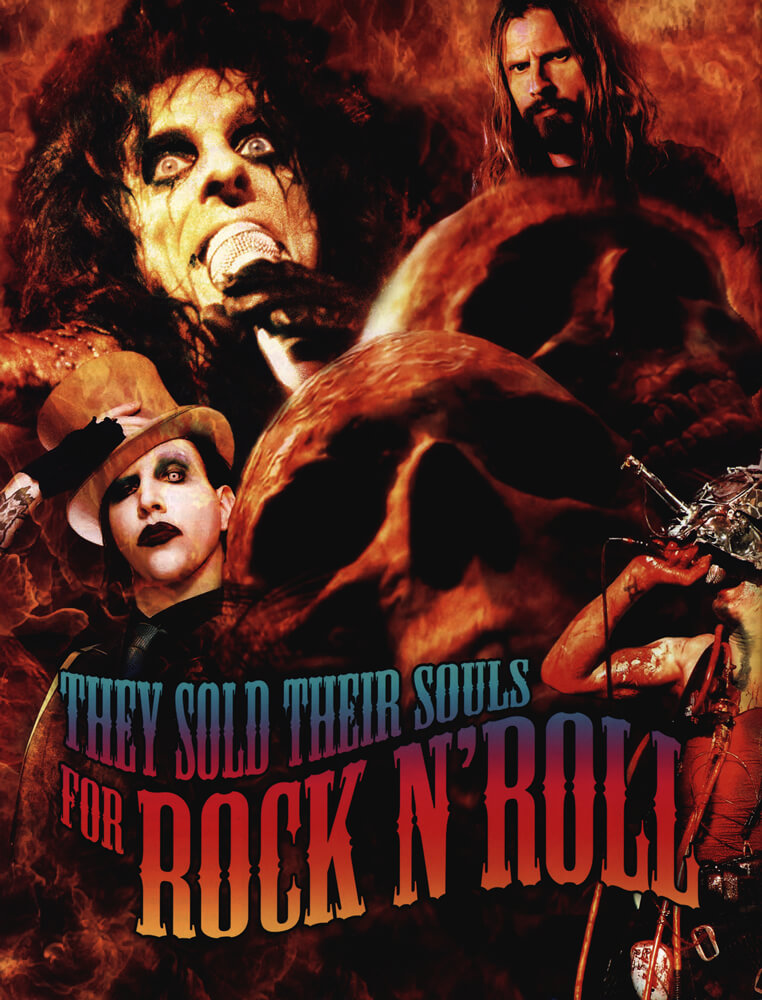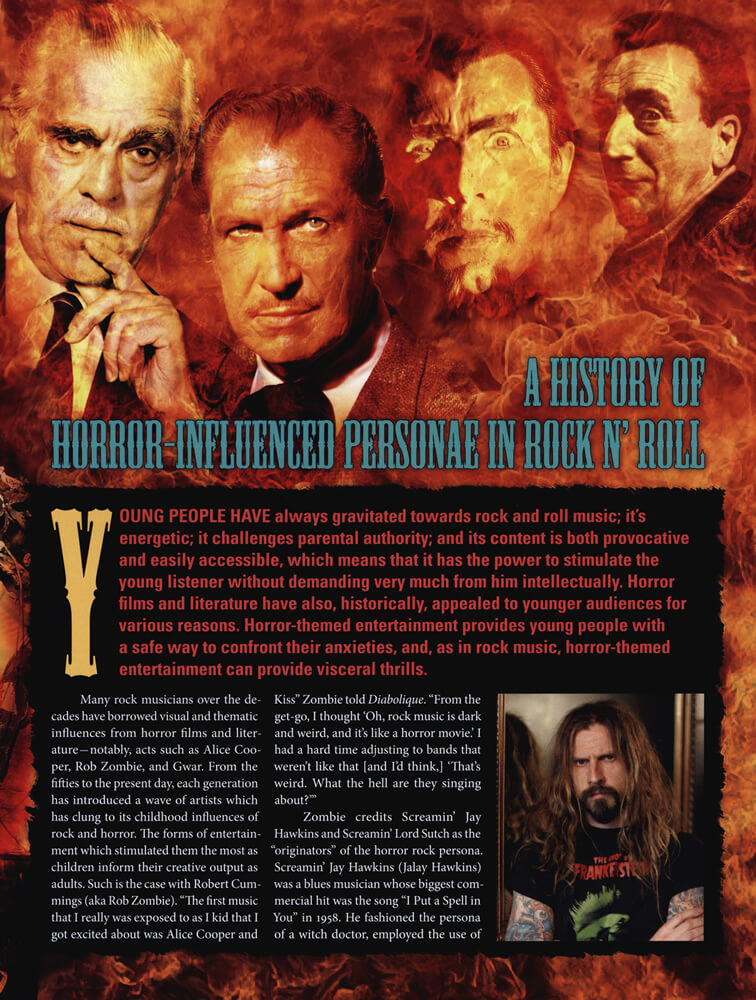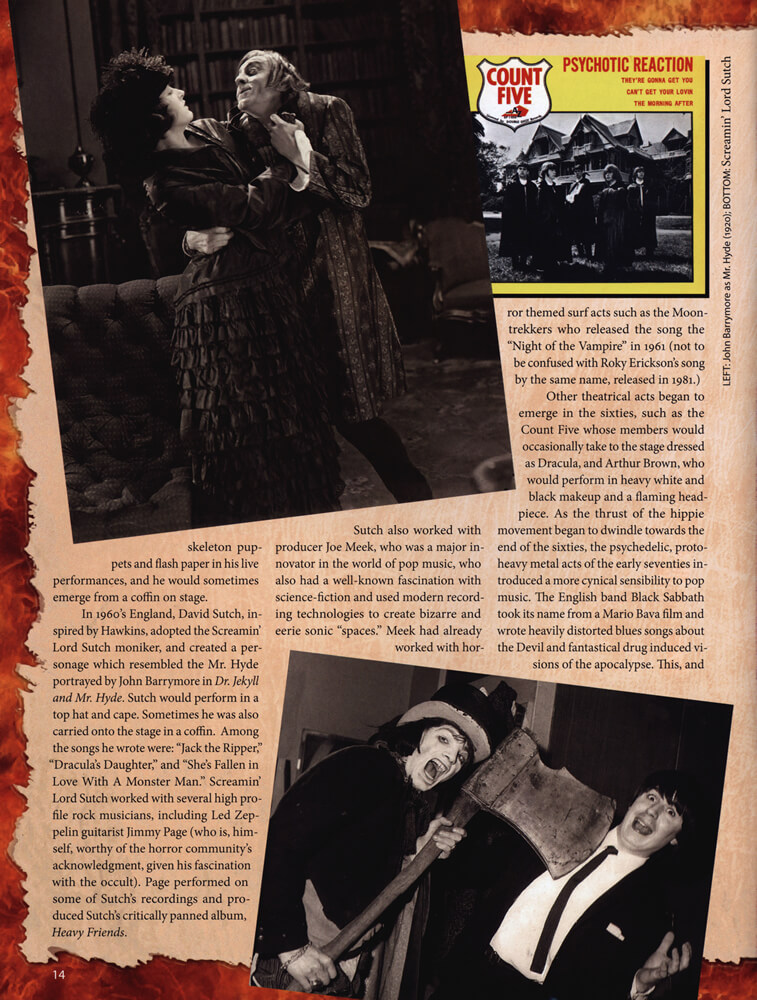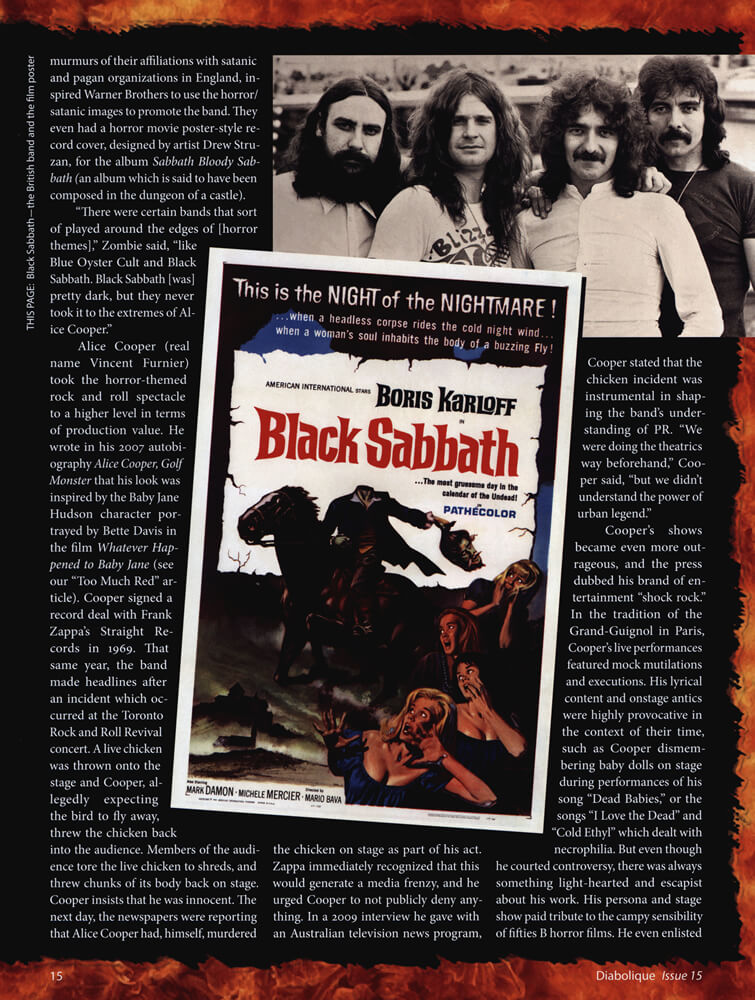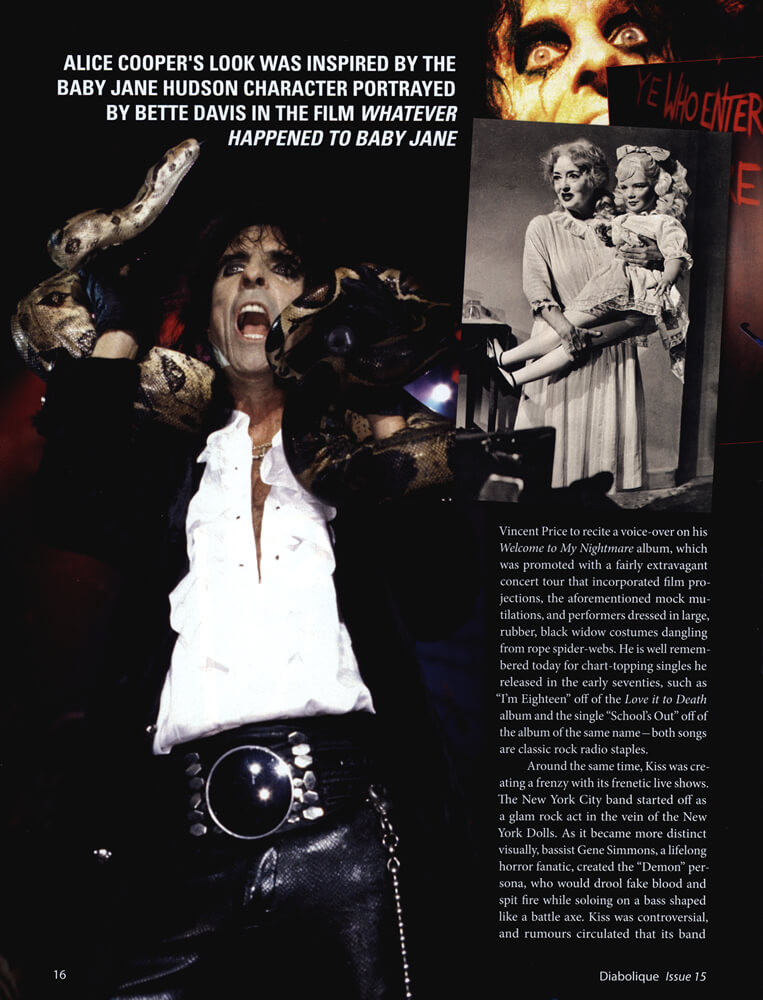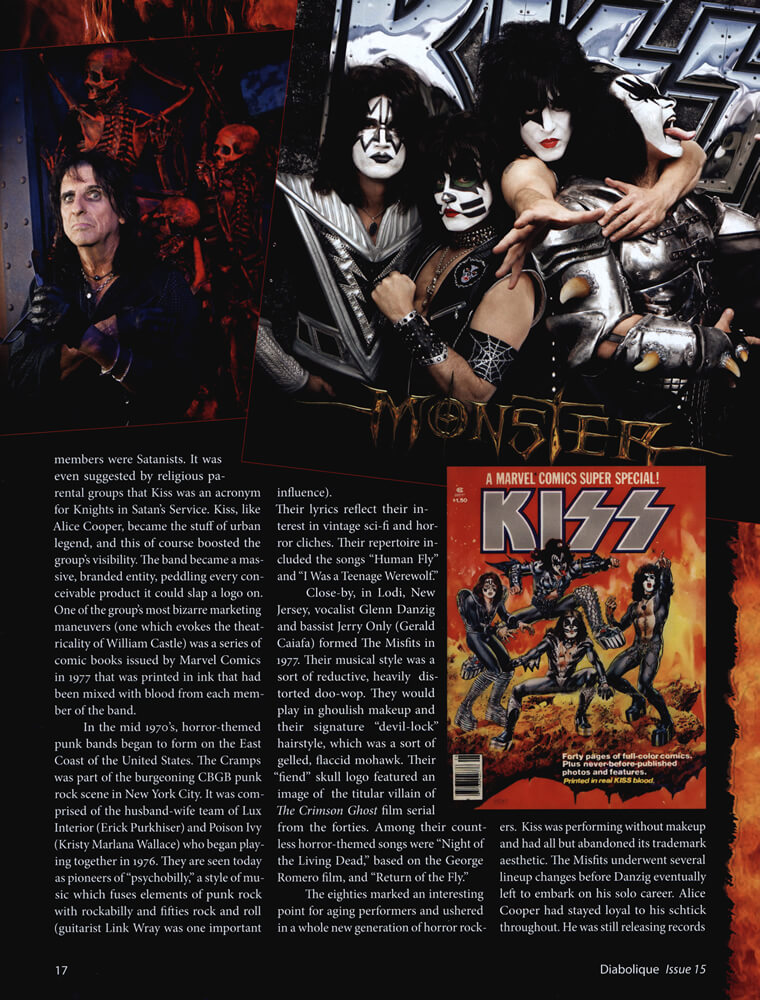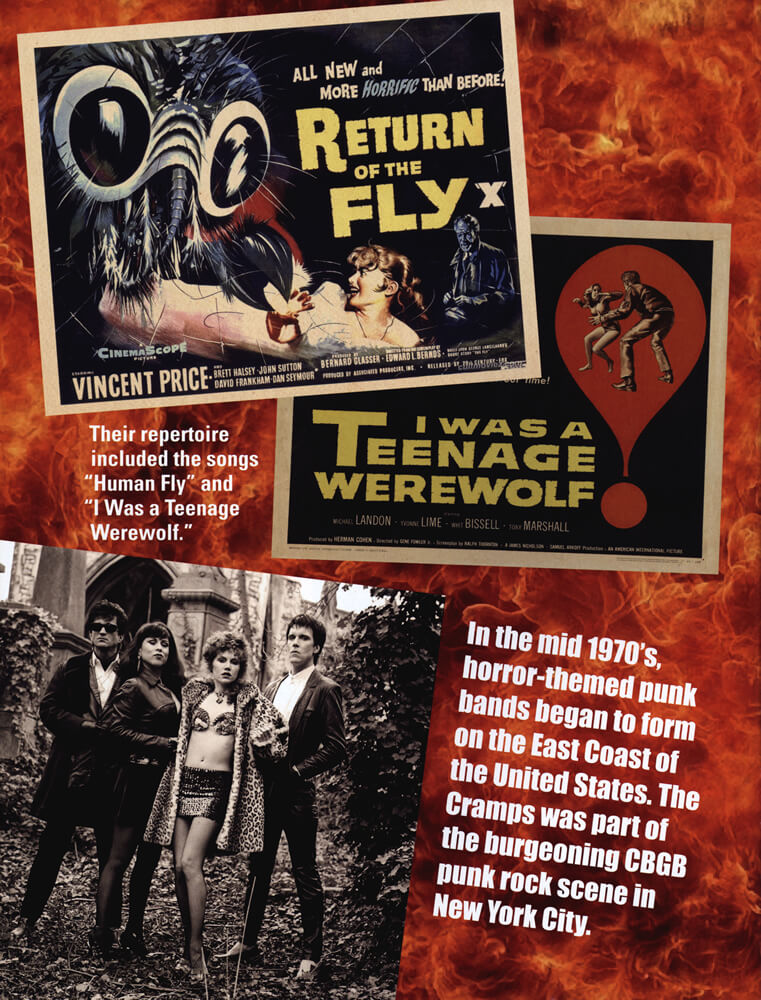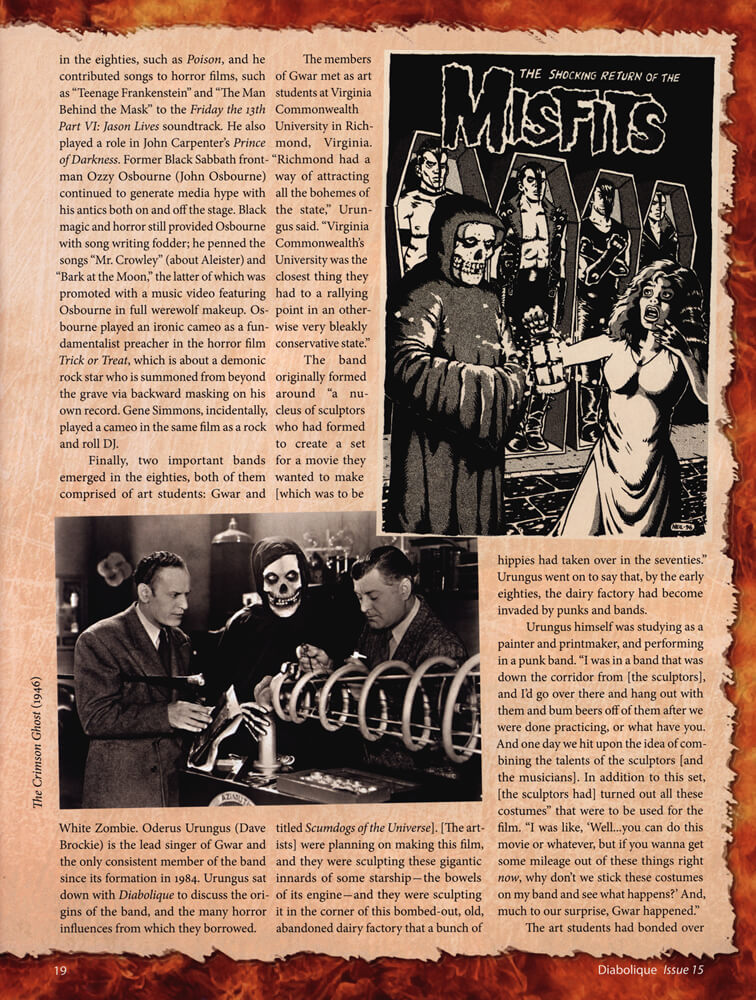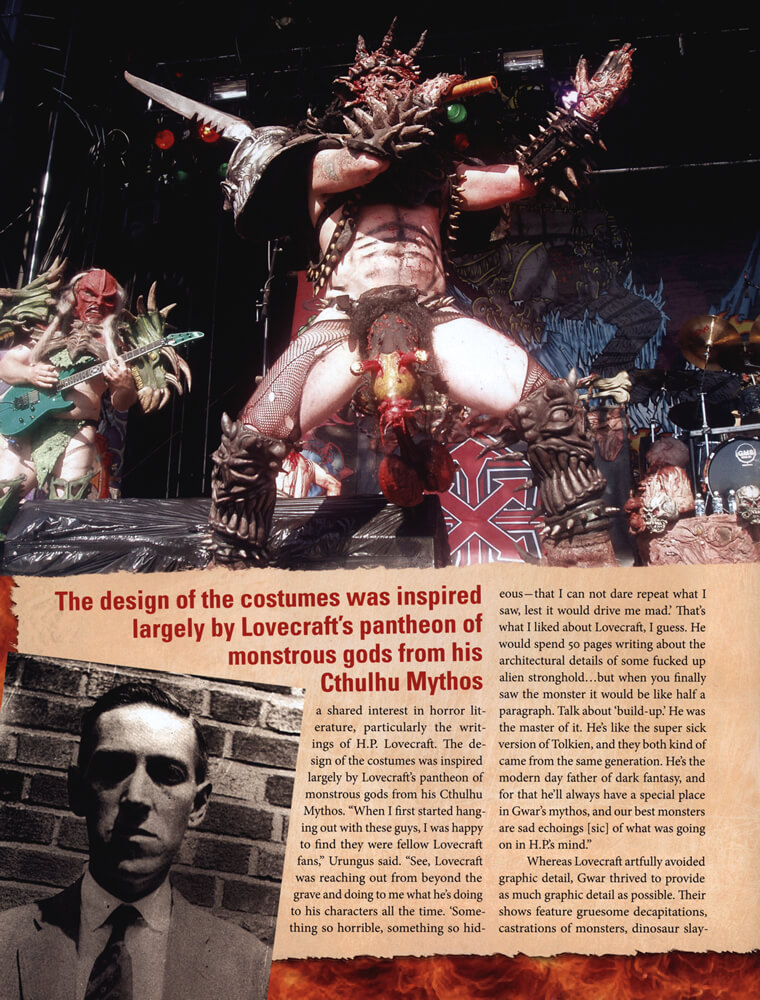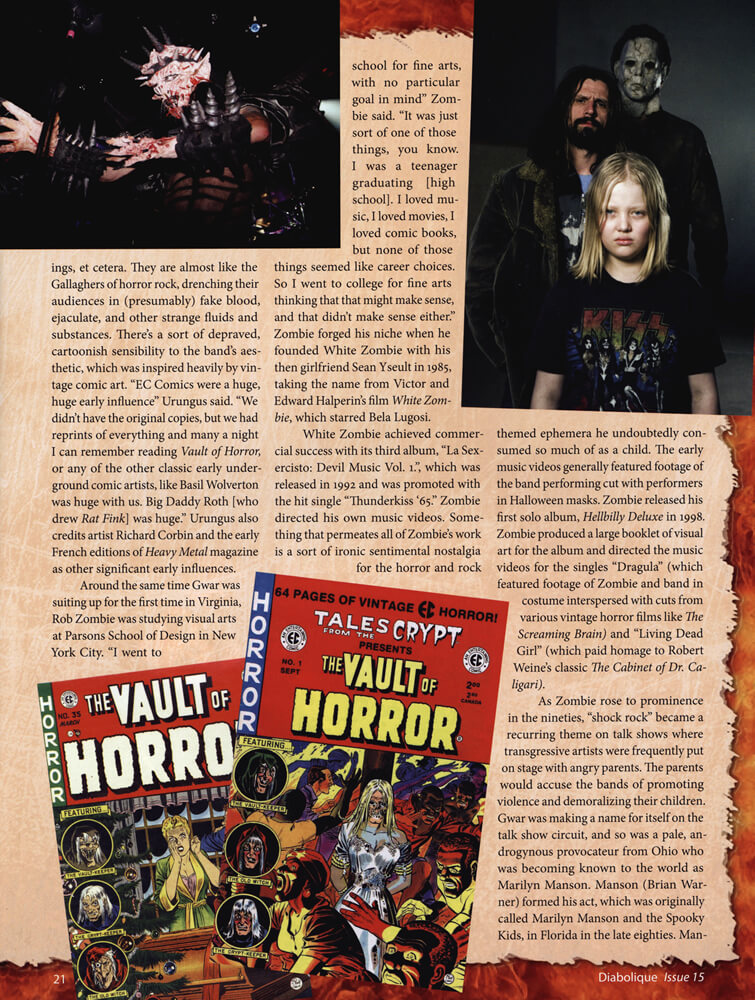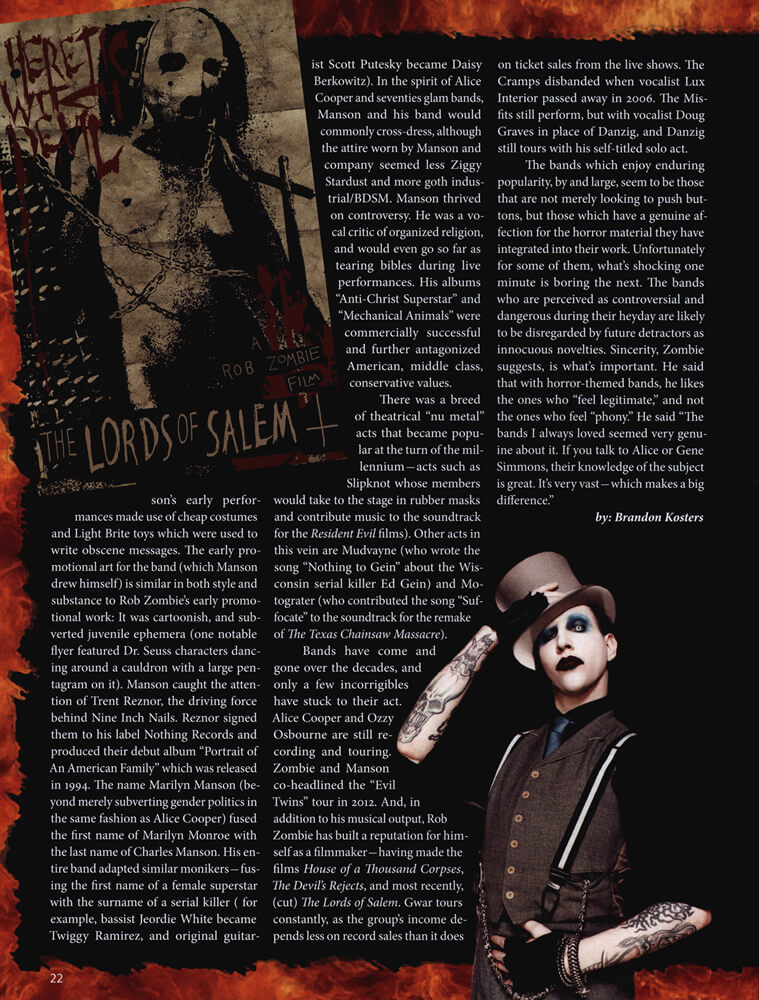Article Database
They Sold Their Souls for Rock n' Roll
A History of Horror-Influenced Personae in Rock n' Roll
YOUNG PEOPLE HAVE always gravitated towards rock and roll music; it's energetic; it challenges parental authority; and its content is both provocative and easily accessible, which means that it has the power to stimulate the young listener without demanding very much from him intellectually. Horror films and literature have also, historically, appealed to younger audiences for various reasons. Horror-themed entertainment provides young people with a safe way to confront their anxieties, and, as in rock music, horror-themed entertainment can provide visceral thrills.
Many rock musicians over the decades have borrowed visual and thematic influences from horror films and literature — notably, acts such as Alice Cooper, Rob Zombie, and Gwar. From the fifties to the present day, each generation has introduced a wave of artists which has clung to its childhood influences of rock and horror. The forms of entertainment which stimulated them the most as children inform their creative output as adults. Such is the case with Robert Cummings (aka Rob Zombie). "The first music I really was exposed to as a kid that I got excited about was Alice Cooper and Kiss," Zombie told Diabolique. "From the get-go, I thought 'Oh, rock music is dark and weird, and it's like a horror movie.' I had a hard time adjusting to bands that weren't like that [and I'd think,] 'That's weird. What the hell are they singing about?'"
Zombie credits Screamin' Jay Hawkins and Screamin' Lord Sutch as the "originators" of the horror rock persona. Screamin' Jay Hawkins (Jalay Hawkins) was a blues musician whose biggest commercial hit was the song "I Put a Spell on You" in 1958. He fashioned the persona of a witch doctor, employed the use of skeleton puppets and flash paper in his live performances, and he would sometimes emerge from a coffin on stage.
In 1960's England, David Sutch, inspired by Hawkins, adopted the Screamin' Lord Sutch moniker, and created a personage which resembled the Mr. Hyde portrayed by John Barrymore in Dr. Jekyll and Mr. Hyde. Sutch would perform in a top hat and cape. Sometimes he was also carried onto the stage in a coffin. Among the songs he wrote were: "Jack the Ripper," "Dracula's Daughter," and "She's Fallin In Love With A Monster." Screamin' Jay Sutch worked with several high profile rock musicians, including Led Zeppelin guitarist Jimmy Page (who is, himself, worthy of the horror community's acknowledgement, given his fascination with the occult). Page performed and produced Sutch's critically panned album, Heavy Friends.
Sutch also worked with producer Joe Meek, who was a major innovator in the world of pop music, who also had a well-known fascination with science-fiction and used modern recording technologies to create bizarre and eerie sonic "spaces." Meek had already worked with horror themed suft acts such as Moontrekkers who released the song "Nightmare of the Vampire" in 1961 (not to be confused with Roky Erickson's song by the same name, released in 1981.)
Other theatrical acts began to emerge in the sixties, such as Count Five whose members would occasionally take to the stage dressed as Dracula, and Arthur Brown, who would perform in heavy white and black makeup and a flaming head-piece. As the thrust of the hippie movement began to dwindle towards the end of the sixties, the psychedelic, proto-heavy metal acts of the early seventies introduced a more cynical sensibility to pop music. The English band Black Sabbath took its name from a Mario Bava film and wrote heavily distorted blues songs about the Devil and fantastical drug induced visions of the apocalypse. This, and murmurs of their affiliations with satanic and pagan organizations in England, inspired Warner Brothers to use the horror/satanic images to promote the band. They even had a horror movie poster-style record cover, designed by artist Drew StruzAn, for the album Sabbath Bloody Sabbath (an album which is said to have been composed in the dungeon of a castle).
"There were certain bands that sort of played around the edges of [horror themes]," Zombie said, "like Blue Oyster Cult and Black Sabbath. Black Sabbath [was] pretty dark, but they never took it to the extremes of Alice Cooper."
Alice Cooper (real name Vincent Furnier) took the horror-themed rock and roll spectacle to a higher level in terms of production value. He wrote in his 2007 autobiography Alice Cooper, Golf Monster that his look was inspired by the Baby Jane Hudson character portrayed by Bette Davis in the film Whatever Happened to Baby Jane. Cooper signed a record deal with Frank Zappa's Straight Records in 1969. That same year, the band made headlines after an incident which occurred at the Toronto Rock and Roll Revival concert. A live chicken was thrown onto the stage and Cooper, allegedly expecting the bird to fly away, threw the chicken back into the audience. Members of the audience tore the live chicken to shreds, and threw chunks of his body back on stage. Cooper insists that he was innocent. The next day, the newspapers were reporting that Alice Cooper had, himself, murdered the chicken on stage as part of his act. Zappa immediately recognized that this would generate a media frenzy, and he urged Cooper to not publicly deny anything. In a 2009 interview he gave with an Australian television news program, Cooper stated that the chicken incident was instrumental in shaping the band's understanding of PR. "We were doing the theatrics way beforehand," Cooper said, "but we didn't understand the power of urban legend."
Cooper's shows became even more outrageous, and the press dubbed his brand of entertainment "shock rock." In the tradition of the Grand-Guignol in Paris, Cooper's live performances featured mock mutilations and executions. His lyrical content and onstage antics were highly provocative in the context of their time, such as Cooper dismembering baby dolls on stage during performances of his song "Dead Babies," or the songs "I Love The Dead" and "Cold Ethyl" which dealt with necrophilia. But even though he courted controversy, there was always something light-hearted and escapist about his work. His persona and stage show paid tribute to the campy sensibility of fifties B horror films. He even enlisted Vincent Price to recite a voice-over on his Welcome to My Nightmare album, which was promoted with a fairly extravagant concert tour that incorporated film projections, the aforementioned mock mutilations, and performers dressed in large, rubber, black widow costumes dangling from rope spider-webs. He is well remembered today for chart-topping singles he released in the early seventies, such as "I'm Eighteen" off of the Love it to Death album and the single "School's Out" off of the album of the same name — both songs are classic rock radio staples.
Around the same time, Kiss was creating a frenzy with its frenetic live shows. The New Your City band started off as a glam rock act in the vein of the New York Dolls. As it became more distinct visually, bassist Gene Simmons, a lifelong horror fanatic, created the "Demon" persona, who would drool fake blood and spit fire while soloing on a bass shaped like a battle axe. Kiss was controversial, and rumours circulated that its band members were Satanists. It was even suggested by religious parental groups that kiss was an acronym for Knights in Satan's Service. Kiss, like Alice Cooper, became the stuff of urban legend, and this of course boosted the group's visibility. Tee band became a massive, branded entity, peddling every conceivable product it could slap its logo on. One of the group's most bizarre marketing maneuvers (one which evokes the theatricality of William Castle) was a series of comic books issued by Marvel Comics in 1977 that was printed in ink that had been mixed with the blood from each member of the band.
In the mid 1970's, horror-themed punk bands began to form on the East Coast of the United States. The Cramps was part of the burgeoning CBGB punk rock scene in New York City. It was comprised of the husband-wife team of Lux Interior (Erick Purkhiser) and Poison Ivy (Kristy Marlana Wallace) who began playing together in 1976. They are seen today as pioneers of "psychobilly," a style of music which fuses elements of punk rock with rockabilly and fifties rock and roll (guitarist Link Wray was one important influence). Their lyrics reflect their interest in vintage sci-fi and horror cliches. Their repertoire included songs "Human Fly" and "I Was a Teenage Werewolf."
Close-by, in Lodi, New Jersey vocalist Glenn Danzig and bassist Jerry Only (Gerald Caiafa) formed The Misfits in 1977. Their musical stuyles was a sort of reductive, heavily distorted doo-wop. They would play in ghoulish makeup and their signature "devil-lock" hairstyle, which was sort of gelled, flaccid mohawk. Their "fiend" skull logo featured an image of the titular villain of The Crimson Ghost film serial from the forties. Among their countless horror-themed songs were "Night of the Living Dead," based on the George Romero film, and "Return of the Fly."
The eighties marked an interesting point for aging performers and ushered in a whole new generation of horror rockers. Kiss was performing without makeup and had all but abandoned its trademark aesthetic. The Misfits underwent several lineup changes before Danzig eventually left to embark on his solo career. Alice Cooper had stayed loyal to his schtick throughout. He was still releasing records in the eighties, such as Poison, and he contributed songs to horror films such as "Teenage Frankenstein" and "The Man Behind The Mask" to the Friday the 13th Part VI: Jason Lives soundtrack. He also played a role in John Carpenter's Prince of Darkness. Former Black Sabbath frontman Ozzy Osbourne (John Osbourne) continued to generate media hype with his antics both on and off the stage. Black magic and horror still provided Osbourne with song writing fodder; he penned the songs "Mr. Crowley" (about Aleister) and "Bark at the Moon," the latter of which was promoted with a music video featuring Osbourne in full werewolf makeup. Osbourne played an ironic cameo as a fundamentalist preacher in the horror film Trick or Treat, which is about a demonic rock star who is summoned from beyond the grave via backward masking on his own record. Gene Simmons, incidentally, played a cameo in the same film as a rock and roll DJ.
Finally, two important bands emerged in the eighties, both of them comprised of art students: Gwar and White Zombie. Oderus Urungus (Dave Brockie) is the lead singer of Gwar and the only consistent member of the band since its formation in 1984. Urungus sat down with Diabolique to discuss the origins of the band, and the many influences from which they borrowed.
The members of Gwar met as art students at Virginia Commonwealth University in Richmond, Virginia. "Richmond had a way of attracting all the bohemes of the state," Urungus said. "Virginia Commonwealth's University was the closest thing they had to a rallying point in an otherwise very bleakly conservative state."
The band originally formed around "a nucleus of sculptors who had formed to create a set for a movie they wanted to make [which was to be titled Scumdogs of the Universe. [The artists] were planning on making this film, and they were sculpting these gigantic innards of some starshipp — the bowels of its engine — and they were sculpting it in the corner of this bombed-out, old, abandoned dairy factory that a bunch of hippies had taken over in the seventies." Urungus went on to say that, by the early eighties, the dairy factory had become invaded by punks and bands.
Urungus himself was studying as a painter and printmaker, and performing in a punk band. "I was in a band and was down the corridor from [the sculptors], and I'd go over there and hang out with them and bum beers off of them after we were done practicing, or what have you. And one day we hit upon the idea of combining the talents of the sculptors [and the musicians]. In addition to this set, [the sculptors had] turned out all these costumes,” that were to be used for the film. "I was like, 'Well... you can do this movie or whatever, but if you wanna get some mileage out of these things right now, why don't we stick these costumes on my band and see what happens?' And much to our surprise, Gwar happened."
The art students had bonded over a shared interest in horror literature, particularly the writings of H.P. Lovecraft. The design of the costumes was inspired largely by Lovecraft's pantheon of monstrous gods from his Cthulhu Mythos. "When I first started hanging out with these guys, I was happy to find they were fellow Lovecraft fans," Urungus said, "See, Lovecraft was reaching out from beyond the grave and doing to me what he's doing to his characters all the time. 'Something so horrible, something so hideous — that I can not dare repeat what I saw, lest it would drive me mad.' That's what I liked about Lovecraft, I guess. He would spend 50 pages writing about the architectural details of some fucked up alien stronghold... but when you finally saw the monster it would be like half a paragraph. Talk about 'build-up.' He was the master of it. He's like the super sick version of Tolkien, and they both kind of came from the same generation. He's the modern day father of dark fantasy, and for that he'll always have a special place in Gwar's mythos, and our best monsters are sad echoings [sic] of what was going on in H.P. 's mind."
Whereas Lovecraft artfully avoided graphic detail, Gwar thrived to provide as much graphic detail as possible. Their shows feature gruesome decapitations, castrations of monsters, dinosaur slayings, et cetera. They are almost like the Gallaghers of horror rock, drenching their audiences in (presumably) fake blood, ejaculate, and other strange fluids and substances. There's a sort of depraved, cartoonish sensibility to the band's aesthetic, which was inspired heavily by vintage comic art. "EC Comics were a huge, huge early influence" Urungus said. "We didn't have the original copies, but we had reprints of everything and many a night I can remember reading Vault of Horror, or any of the other classic early underground comic artists, like Basil Wolverton was huge with us. Big Daddy Roth [who drew Rat Fink] was huge." Urungus also credits artist Richard Corbin and the early French editions of Heavy Metal magazine as other significant early influences.
Around the same time as Gwar was suiting up for the first time in Virginia, Rob Zombie was studying visual arts at Parsons School of Design in New York City. "I went to school for fine arts with no particular goal in mind," Zombie said. "It was just sort of one of those things, you know. I was a teenager graduating [high school]. I loved music, I loved movies, I loved comic books, but none of those things seemed like career choices. So I went to college for fine arts thinking that that might make sense, and that didn't make sense either." Zombie forged his niche when he founded White Zombie with his then girlfriend Sean Yseult in 1985, taking the name from Victor and Edward Halperin's film White Zombie, which starred Bela Lugosi.
White Zombie achieved commercial success with its third album, "La Sexercisto: Devil Music Vol. 1", which was released in 1992 and was promoted with the hit single "Thunderkiss '65." Zombie directed his own music videos. Something that permeates all of Zombie's work is a sort of ironic sentimental nostalgia for the horror and rock themed ephemera he undoubtedly consumed so much of as a child. The early music videos generally featured footage of the band performing cut with performers in Halloween masks. Zombie released his first solo album, Hellbilly Deluxe in 1998. Zombie produced a large booklet of visual art for the album and directed the music videos for the singles "Dragula" (which featured footage of Zombie and band in costume interspersed with cuts from various vintage horror films like The Screaming Brain) and "Living Dead Girl" (which paid homage to Robert Weine's classic The Cabinet of Dr. Caligari).
As Zombie rose to prominence in the nineties, "shock rock" became a recurring theme on talk shows where transgressive artists were frequently put on stage with angry parents. The parents would accuse the bands of promoting violence and demoralizing their children. Gwar was making a name for itself on the talk show circuit, and so was a pale, androgynouse provocateur from Ohio who was becoming known to the world as Marilyn Manson. Manson (Brian Warner) formed his act, which was originally called Marilyn Manson and the Spooky Kids, in Florida in the late eighties. Manson's early performances made use of cheap costumes and Lite Bright toys which were used to write obscene messages. The early promotional art for the band (which Manson drew himself) is similar in both style and substance to Rob Zombie's early promotional work: It was cartoonish, and subverted juvenile ephemera (one notable flyer featured Dr. Suess characters dancing around a cauldron with a large pentagram on it). Manson caught the attention of Trent Reznor, the driving force behind Nine Inch Nails. Reznor signed them to his label Nothing Records and produced their debut album "Portrait of An American Family" which was released in 1994. The name Marilyn Manson (beyond merely subverting gender politics in the same fashion as Alice Cooper) fused the first name of Mariyln Monrow with the last name of Charles Manson. His entire band adopted similar monikers — fusing the first name of a female superstar with the surname of a serial killer (for example, bassist Jeordie White became Twiggy Ramirez, and original guitarist Scott Putesky became Daisy Berkowitz). In the spirit of Alice Cooper and seventies glam bands, Manson and his band would commonly cross-dress, although the attire worn by Manson and company seem less Ziggy Stardust and more goth industrial?BDSM. Manson thrived on controversy. He was a vocal critic of organized religion, and would even go so far as tearing bibles during live performances. His albums "Anti-Christ Superstar" and "Mechanical Animals" were commercially successful and further antagonized American, middle class, conservative values.
There was a breed of theatrical "nu metal" acts that became popular at the turn of the millenium — acts such as Slipknot whose members would take to the stage in rubber masks and contribute music to the soundtrack for the Resident Evil films. Other acts in this vein are Mudvayne (who wrote the song "Nothing to Gein" about the Wisconsin serial killer Ed Gein) and Motograter (who contributed the song "Suffocate" to the soundtrack for the remake of Texas Chainsaw Massacre).
Bands have come and gone over the decades, and only a few incorrigibles have stuck to their act. Alice Cooper and Ozzy Osbourne are still recording and touring. Zombie and Manson co-headlined the "Evil Twins" tour in 2012. And, in addition to his musical output, Rob Zombie has built a reputation for himself as a filmmaker — having made the filmes House of a Thousand Corpses, The Devil's Rejects, and most recently, The Lords of Salem. Gwar tours constantly, as the group's income depends less on record sales than it does on ticket sales from the live shows. The Cramps disbanded when vocalist Lux Interior passed away in 2006. The Misfits still perform, but with vocalist Doug Graves in place of Danzig, and Danzig still tours with his self-titled solo act.
The bands which enjoy enduring popularity, by and large, seem to be those that are not merely looking to push buttons, but those which have a genuine affection for the horror material they have integrated into their work. Unfortunately for some of them, what's shocking one minute is boring the next. The bands who are perceived as controversial and dangerous during their heyday are likely to be disregarded by future detractors as innocuous novelties. Sincerity, Zombie suggests, is what's important. He said that with horror-themed bands, he likes the ones who "feel legitimate," and not the ones who feel "phony." He said "The bands I always loved seemed very genuine about it. If you talk to Alice or Gene Simmons, their knowledge of the subject is great. It's very vast — which makes a big difference."
(Originally published in Diabolique magazine, March/April 2013, Issue #15)



